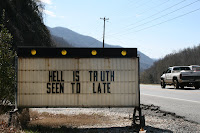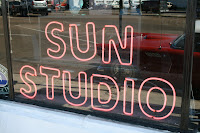 The USA is an enormous country where the car is king. Travelling around by public transport is not the norm and even most guidebooks assume you are driving everywhere. Gathering information about public transport has been time consuming, so to save you the hassle here‘s what we found out.
The USA is an enormous country where the car is king. Travelling around by public transport is not the norm and even most guidebooks assume you are driving everywhere. Gathering information about public transport has been time consuming, so to save you the hassle here‘s what we found out. Buses
It is possible to get around most of the US on the bus, although in comparison to Mexico the bus system is far behind. Greyhound has elicited groans for years, and yes it is grim, but thankfully some better buses, such as Megabus, are starting to challenge their stranglehold.
If you’re first in the queue for the bright blue double-decker Megabus you can secure a table and four chairs in front of a video screen, and if you’re lucky they will be playing films. The seats are comfy with leg room and the onboard toilet is useable. Despite the better qua
 lity the prices are often cheaper than Greyhound. We met a woman who had bought a return from Chicago to Detroit (a five and a half hour journey) for $2.50. Buy in advance and you can get a real bargain. They keep their prices low by offering a no-frills service; you can only buy tickets on-line (you get a reservation code that you show upon boarding), you have to put your bags in the hold yourself and they have no bus stations (only bus stops by the side of the road). The only disadvantages that we found are that the service only serves the north/northeast of the country and if the weather is bad you have to wait for the bus in the rain.
lity the prices are often cheaper than Greyhound. We met a woman who had bought a return from Chicago to Detroit (a five and a half hour journey) for $2.50. Buy in advance and you can get a real bargain. They keep their prices low by offering a no-frills service; you can only buy tickets on-line (you get a reservation code that you show upon boarding), you have to put your bags in the hold yourself and they have no bus stations (only bus stops by the side of the road). The only disadvantages that we found are that the service only serves the north/northeast of the country and if the weather is bad you have to wait for the bus in the rain.The Megabus drivers are great entertainment, each seemingly running their bus in the manner they seem fit. Our Chicago to Minneapolis driver made the rules of the journey clear to its mainly springbreak passengers,
“No chewing gum loudly - no smacking or cracking. Gentlemen please raise the toilet seat and put it down again. Don’t play music loudly - that’s what headphones are for.”
On the other hand Durrl (spelt Darryl on his name badge), our Minneapolis to Chicago driver, was a one man entertainment machine. He was playing his personal collection of DVDs (“I thought the kids might like Iron Man”) and was genuinely sorry when the DVD kept skipping over the rutted roads of the Mid-West. He grinned back over his shoulder, while battling to keep the bus upright in strong winds and rain, until he got the thumbs up from us that the volume was fine. As Blades of Glory skipped itself to the end Darryl changed tack and got on the PA system,
“Ladies and gentlemen, for the first time ever in Megabus history this is your chance to come down to the front and make an announcement over the microphone. Come on down!” No-one budged so Darryl continued,
“We got a beautiful girl upstairs on her way to become America’s Next Top Model and we got some world travellers sitting here right behind me on the lower deck.” A shout-out on the Megabus - it doesn’t get much classier than that! And on he whittered congratulating people for the size of their phone or the food they were eating until finally some passengers came down the stairs and grabbed the mike,
“I’d like to say thank you to the driver for getting us here safely and to say happy birthday to my nieces for Thursday.” A round of applause. Durrl liked that and came back with an Eddie Murphy style,
“O, o, oooh! We’re gliding like Egyptian silk!” This man clearly enjoys his job and made the eight hour bus journey so much shorter. Public transport has never been such fun.
There are, apparently, a few bus companies travelling between one city’s Chinatown to the next (various websites, just google ‘Chinabus‘), but again only serves the northeast at present. The buses are, apparently, of about the same standard as the Greyhound, but are cheaper. Boston bus station has a particularly good array of bus companies serving different destinations.
When all else fails there is the Greyhound. It does connect to most cities in the US and is often cheaper th
 an taking the train. We didn’t find it a dangerous experience, just a depressing one, with some of the worst customer service we’ve encountered on our trip. However, it works and we used it extensively between Texas and Ohio. Check for deals online and, if you can, book ahead because when you book more than three days in advance your travel partner gets a half-price ticket. You need to arrive at the Greyhound station an hour before departure to pick-up tickets (you just get a reservation code online) or to purchase tickets. They never seem to sell out, and if a bus is full they just put on another one for the same journey.
an taking the train. We didn’t find it a dangerous experience, just a depressing one, with some of the worst customer service we’ve encountered on our trip. However, it works and we used it extensively between Texas and Ohio. Check for deals online and, if you can, book ahead because when you book more than three days in advance your travel partner gets a half-price ticket. You need to arrive at the Greyhound station an hour before departure to pick-up tickets (you just get a reservation code online) or to purchase tickets. They never seem to sell out, and if a bus is full they just put on another one for the same journey.When you’ve bought your ticket put your bags in the queue by the departure gate - you want to be one of the first on the bus so you can pick good seats (we prefer near the front and as far away from smelly people as possible). You and your hand luggage may be subject to an airport style security check and frisk, as was the case in Memphis, so keep penknives, scissors, nail files etc. in your backpack for the hold and not in your hand luggage. Greyhound buses are fairly standard coaches but lack the comfort and movies of the Mexican buses, so take your own entertainment.
Both the Megabus and the Greyhound stop every few hours for a loo and food break. Greyhound seems to have a close relationship with fastfood chains, whereas the Megabus usually stops at a service centre where you can make your own choice.

Trains
Travelling by train is definitely our preferred method of public transport in the US. The seats are comfy with plenty of legroom, there are plug sockets so you can work on your laptop, there’s a dining car and the toilets are acceptable. They are better than British trains in terms of comfort, although delays are also not unusual.
The view from the train is often much better than the soulless, corporate chain lined interstates that the buses favour. The train can take you through farmland and forests and alongside rivers and lakes.
Amtrak runs the trains in the States. You can buy tickets on line or at the station, with online sales offering the best deals. There are
 weekly ‘hot deals’ and if you are planning to travel extensively during a two or three week period, a rail pass could be a good option.
weekly ‘hot deals’ and if you are planning to travel extensively during a two or three week period, a rail pass could be a good option.Turn up 30 minutes to an hour early to collect your tickets (if purchased online) and wait to be directed, or sometimes escorted, to the train. The waiting areas in the stations are generally more comfortable than those for buses.
The only drawbacks for us have been that Amtrak does not operate services across the whole country and only in the northeast does the service seem to be frequent.
Travelling around the States on public transport is perfectly possible, provides a great insight into parts of America you might not otherwise encounter and can even be great fun. If only there was a Durrl on every train and bus!
Read more...








































